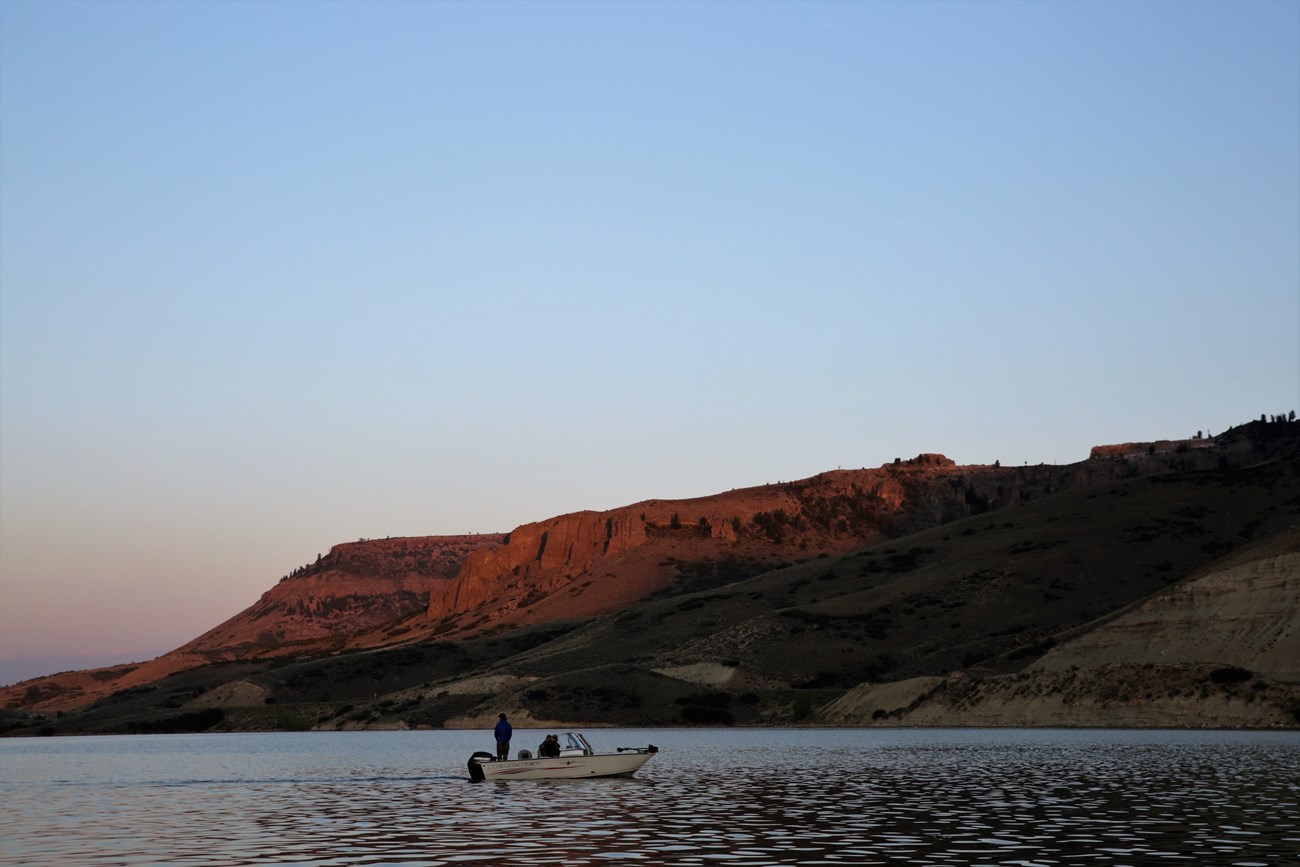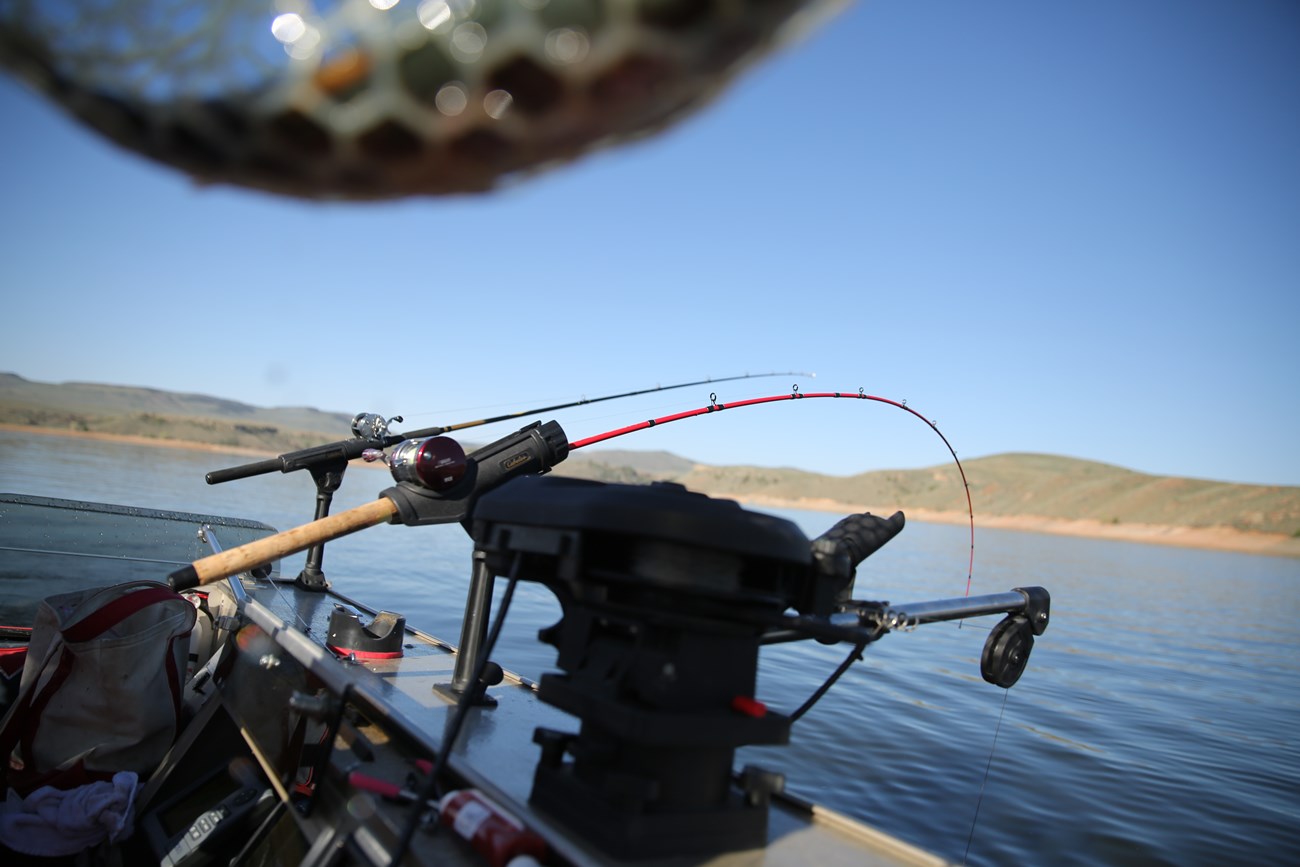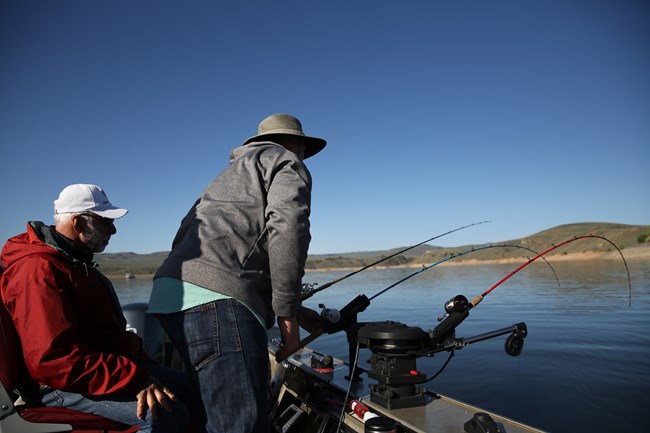Last updated: June 4, 2018
Article
Trolling

NPS Photo / Forrest Czarnecki
The boat softly rocks back and forth as it glides through the emerald-colored lake water. You watch your rod patiently when all of a sudden you notice the tip diving up and down. You pull the rod out of the holster and feel something tugging on the line. Then you realize you have a fish on!
This is an example of what fishing is like when you’re trolling. While there are many ways to enjoy fishing in National Park Service (NPS) waterways, trolling can be one of the most exciting ones. Always check park regulations to check if trolling is allowed in the park you want to visit.
What Is Trolling?
Trolling is a very “active” type of fishing. This means that it requires more attention, effort, and gear than some other types of fishing. But it’s one of the most exciting and rewarding types of fishing!
Trolling is always done from a boat, canoe, or other type of watercraft (such as a kayak or belly boat). When trolling, a lure or artificial fly is dragged through the water behind a watercraft at varying depths and speeds. The depth and speed at which a lure is trolled depends on the species of fish you’re after.
Be sure to check park regulations before your trip, some types of motors may not be allowed in certain park waterways.
Gear for Trolling
Trolling requires more fishing gear than most other types of fishing. Here’s a list of some of the gear needed for trolling:
-
Valid fishing license
-
Boat or other type of personal watercraft
-
Trolling motor
-
The proper fishing rod and lure
-
A pair of needle nose pliers to safely remove the lure from the fish’s mouth
-
Fishing net (one with rubber or knotless mesh)
-
Fish finder (sonar) *optional*
-
Downrigger *optional for some species*
When you pick out your lures and gear, be aware of any park regulations that prohibit the use of lures containing lead.
Check park boating regulations before heading out on your next adventure. Some parks or waterways may not allow certain types of watercraft or trolling motors. Always obey laws regarding the usage of personal flotation devices (PFDs) and other regulations for watercraft operation.

NPS Photo / Forrest Czarnecki
How to Troll
First, you’ll need to consider the fish species you want to catch. This will help you select the proper rod and lures for trolling.
Once you select your rod and lures, you’ll need to decide how you want to troll. There are two common methods of trolling, using a flatline or downrigger.

NPS Photo / Forrest Czarnecki
Flatline
Trolling with a flatline means you’ll be trolling with just a rod and lure (no downriggers), and your lure will be close to the surface of the water.
When fishing with a flatline, the lure is cast out behind the boat. Then the angler needs to let out more fishing line in a controlled manner. This will allow the lure to follow further behind the watercraft, where fish won’t be scared by the noise or shadow of the boat.
Once the lure is at the desired distance behind the boat, the proper speed needs to be chosen. The best speed for trolling depends on the type of lure used and the species desired. Trolling with a flatline is always done at slower speeds (less than 5 mph—there should be no wake when trolling).
After the speed is set and the lure is at the desired distance, the rod can either be placed in a secure rod holder or held by the angler.
The speed at which you troll will help determine the depth of your lure. Anglers can also attach small clip-on weights to their line to make it sink when trolling.

NPS Photo / Forrest Czarnecki
Downriggers
A downrigger is a device that is attached to the boat, and it helps get the lure down deeper than using a flatline (usually 20 feet deep or more). A downrigger is like a small crane with a heavy weight on the end of a long steel cable. This heavy weight is what helps get the lure to the desired depth.
When using a downrigger, the fishing line is attached to the weight (called a ball) with a small clip. A common practice is to have anywhere from 10 to 20 feet of line between the fishing lure and where the line is clipped to the ball. The release pressure of the clip should be adjustable. The clip should be strong enough to hold the line and lure, but light enough to let go of the line when a fish strikes.
Once the line is clipped to the ball, it’s ready to be sent to the desired depth. When the downrigger ball is sent down with the fishing line attached, be sure to release line from the fishing reel in a controlled manner. This will help keep the line attached to the clip, and prevent knots in the reel.
After the ball and line is at the desired depth, the rod can be placed in a secure rod holder or held by the angler. You’ll want to keep some bend in the rod when the line is attached to the ball—the upper third of the rod should have a nice, rounded shape leaning toward the water. This will help you detect bites and set the hook if a fish takes the lure.
The next step is to set the proper speed. The speed at which you troll will depend on the desired fish species. Trolling with a downrigger is always done at slower speeds (less than 5 mph—there should be no wake).
When a fish strikes the lure, the rod tip will dive up and down suddenly in a dramatic motion. Be ready to set the hook if the rod tip keeps diving! You can set the hook with a sharp upward pull of the rod.
If you’re trolling with downriggers, be mindful of what’s underwater and be careful not to damage any park resources or underwater habitat.
Expectations for Trolling
Because trolling requires more effort and gear than most types of fishing, it may be better to hire a professional guide if you want to give it a try. Check out local guides and see what options they offer. A guided expedition may be a good way to dip your toe into the world of trolling. Before hiring a guide or outfitting service, check to make sure they are accredited and legally licensed.
If you choose to give trolling a shot on your own, expect to put in some work in order to catch some fish. Research the location and desired fish species before your trip to increase your odds of success.
Trolling is one of the most exciting and entertaining forms of fishing. Whether you’re after a picture-worthy walleye or 40-pound lake trout, trolling is one of the best ways to enjoy NPS waterways.

NPS Photo / Forrest Czarnecki
